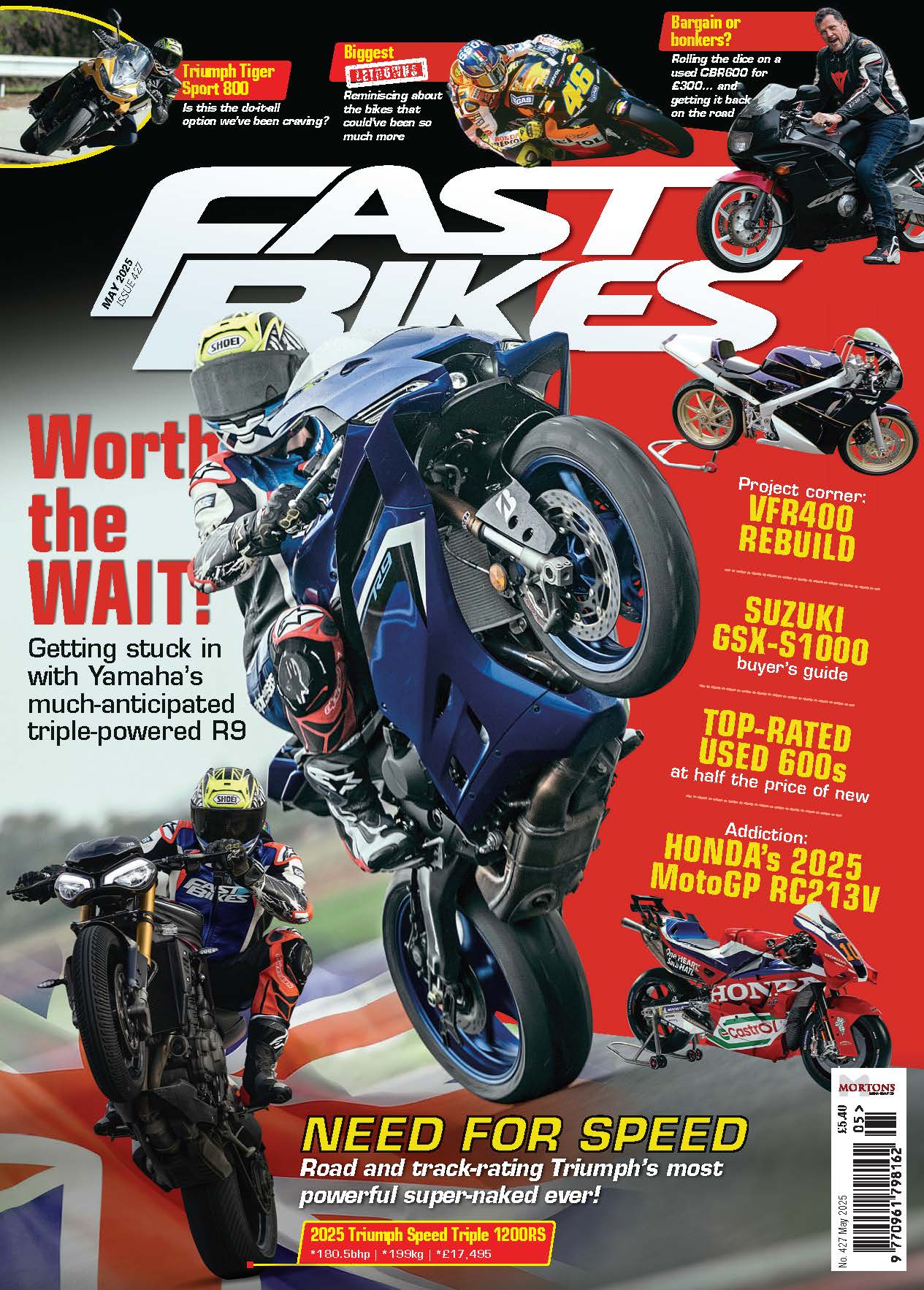More focused than your typical naked, but not quite a sportsbike… is this the halfway house we’ve been hoping for?

Words: Big Mac
Pics: Double Red
Back in February, when Triumph launched its heavily updated Street Triple 765 to the media, it also announced a bling ‘Moto2’ edition, but didn’t bring it to Jerez, in Spain, for us to ride. At the time I will admit to not really understanding why you would do that, especially when you’ve gone to the expense of hiring Jerez race circuit. Why wouldn’t we all be let loose on a track where a round of the Moto2 world championship is held, on one of its bike bearing the Moto2 logo, on account of Triumph being the engine supplier to the class, and tie it all in together? Having just got in from my first hour or so riding the Moto2, I now know why…
It’s actually pretty obvious – and also tells you more or less everything you need to know about the Moto2. If they did let us ride the Moto2 alongside the RS and R versions, it would certainly have diluted the focus on what are actually more important bikes for Triumph, the big-selling R and RS. Plus, given there’s only going to be 1530 Moto2s on the planet – 765 of each colour – and they pretty much all sold out as soon as Triumph made the announcement, they rightly got us to focus on the R and RS back in the winter and deliver the good news about those to our respective audiences.
However, we were still left with questions that needed answering, the main one being, ‘What’s it like?’ All those upgrades that really sharpened the Street Triple for 2023, plus clip-ons and Öhlins all-round, are a mouth-watering prospect. Obviously, there are other things the Moto2 gets that the other Street Triples don’t, but they’re all cosmetic. Stuff like the paint job, obligatory build number plaque, some snazzy carbon fibre here and there and, of course, the aforementioned official Moto2 logos dotted around, too.
At this point it’s worth a quick reminder of what the 2023 Street Triple got by way of upgrades for 2023. The latest version of the three-cylinder 765cc motor gets shorter inlet trumpets to increase inlet velocity, re-profiled inlet ports, higher lift cams to open the valves more, which means longer valves, a re-profiled combustion chamber and piston crown to increase the compression ratio to 13.25:1, and a new higher flowing exhaust with less angular bends and only one catalytic converter. The result is an impressive 7bhp increase over the previous motor. It’s such a big jump in power that the motor also gets new, stronger con-rods and gudgeon pins to cope.
Triumph also went a bit mad in the gearbox on new bike. The ratios are all lower than before, except first gear, which is a tiny bit taller. Then there is the final drive, which has one tooth less on the front sprocket and two teeth more on the rear sprocket. Put all that lower gearing together with the big boost in power and you really shouldn’t need me to tell you that the 2023 Street Triple is much livelier than the previous one. The shorter gearing means that the wheelbase is 6mm shorter – a significant amount, plus the rear ride height has been raised by 10mm, which is also a large change. Raising the ride height creates the byproduct of also reducing the rake of the steering very slightly, so the overall combination of the changes to the geometry put the Street Triple on its nose a lot more than the previous one for quicker steering, and a shorter wheelbase for greater agility.
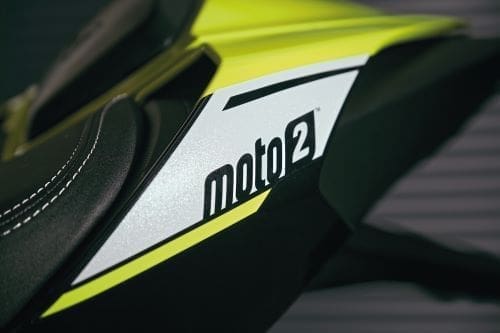
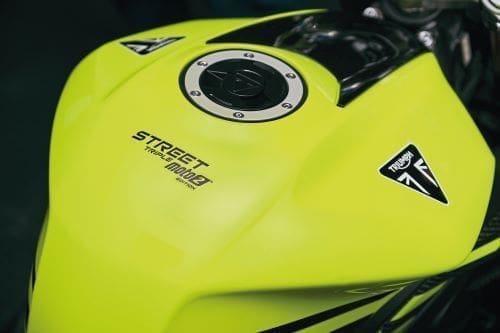
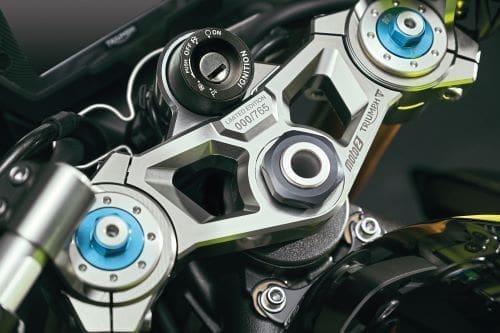

One other change to the Street Triple probably worth mentioning is that the handlebars are 12mm wider to introduce more leverage into the mix, too – remember that number for later. The geometry changes are as significant as the engine changes in terms of how far away the 2023 bike has moved from the 2022 bike. Now throw in the Moto2 changes to the R and RS models – specifically its handlebar position, which is 80mm lower and 50mm further forward, which is obviously massive… so big, in fact, that you can see it clearly with the naked eye, which you can’t often say about riding position or geometry changes. As I said, a wheelbase reduction of 6mm is massive, but no way can you see it standing next to the bike; not so with the Moto2’s different handlebar position. Speaking of the handlebars, they are things of utter beauty, in particular how they’re fixed to the milled top yoke via equally gorgeous – and small – risers. The Öhlins forks, complete with blue anodised tops and adjustors, poke through to complete the vision of quality; it’s a nice view when you’re riding along. The layout of the full colour display still irritates me, though, for being so impossible to locate any meaningful information due to the sheer amount of clutter on it.
So, recap over with, the burning question is: does the Street Triple Moto2 fill the space left behind by the Daytona – minus fairing? Or is it something different altogether? Does it fall between two stools and not deliver on either the supersport level or the posh naked bike level? The short answer is neither nor both, which doesn’t really help. Allow me to explain…
That it hasn’t got a fairing means you get the full force of the wind blast, plus the handlebars are just too wide and still not low enough to be in the ballpark for where you’d want them on a supersport bike. Equally, they are too low for the kind of naked bike riding position at the heart of why naked bikes are so easy and fun to ride. There’s enough of your weight pitched over the front of the Moto2 for it to be nothing like a naked bike, but the very wide handlebars are the things that take the most getting used to. It’s a very alien riding position, and I can’t think of another bike with one like it. The overall effect is that the Moto2 really does corner even harder than the RS, which I heaped tonnes of deserved praise on for how much it liked railing hard into corners.

The way the front end on the Moto2 feeds back to you due to the added weight over it is instantly noticeable, and screams grip and confidence – just like a supersport bike. At times, it feels like your hands are connected directly to the front wheel spindle, such is the feeling of being connected to the front tyre. On any naked bike, the price to pay for that easy and playful riding position is less weight over the front wheel, which means there’s less load going through the front tyre, which means less information – it’s physics. The lower bars also mean that at higher speed, the Moto2 is much more stable; not that the RS is in any way unstable at speed, it’s just that the Moto2, due to having less of the rider as part of the aero frontal area, has less lift at speed. If the RS is perfectly stable at speed, the Moto2 is planted. It’s all very confusing at first, because it’s a naked bike experience – but not like any other I’ve had before.
The Öhlins forks are the other major difference to the Moto2, and which also account for most of the £2500 price difference between it and the RS. They’re trick things and clearly out of the top drawer, but then so are the Showa BPF forks in the RS, which are also fully adjustable and gave me no cause for complaint at the bike’s road and track launch. That said, at 43mm the diameter of the Öhlins forks in the Moto2 is 2mm thicker than the RS’s, which is very much one of those things you can definitely feel rather than see. The added stiffness from the extra diameter does without doubt contribute to the overall feeling of the Moto2 being a front end dominated bike. Triumph claims that the forks have their own bespoke set-up compared to the forks in the RS on account of the different weight distribution, and knowing just how much attention to detail Triumph and its test riders go to, I believe this. They’ve got a lovely, consistent action when you pull hard on the brake lever and strike that lovely balance between suppleness and support. They also respond well to adjustment. I felt the need to investigate the settings both front and rear, suspicious that a previous user of the bike might have been twiddling a bit, shall we say… aimlessly. Sags measured and reset, then 10 minutes with a 3mm allen key, with some bouncing at each end of the bike, and it was transformed by closing the compression and rebound damping in the rear shock by just three clicks and adding a turn of preload to the forks to take up some of the excess sag they had.
The transformation in how the bike felt reminded me of the Ducati Monster SP, and how that came to life with literally just a couple of clicks to the damping when I rode it a few months ago. In fact, the comparison doesn’t end there because in terms of price point at least, the Ducati is the Moto2’s only real competitor in the showroom. It too is a very high-spec middleweight naked bike for not much change out of £14,000 – it’s a niche product, for sure. At the time I said that the Ducati was really in a class of one. Now I’ve ridden the Moto2, I could correct myself and say there are two bikes in the class – but there isn’t, really. For starters, the Moto2 is sold out, so if you want one, you’ll have to wait for one of the lucky owners to sell theirs. Then there’s the fact that they both serve up very different riding experiences. Whereas the Ducati is a highly refined and high-spec version of an existing formula that we all know and understand, the Moto2 is something entirely different. It’s got a level of focus in how it rides that belies its naked bike appearance and label, which leads me to the thing I struggle with the most with the Moto2.

I’m not a fan of distance between the seat and handlebars. It’s too close for me, and I accept that I’m a giant, but the palms of my hands feel like they sit right on the very top of the bars, which, apart from feeling odd, does mean whenever I was braking heavily, the base of my thumbs took all the weight through the bars and not my palms. After an hour or so of back road blasting, my thumbs were actually quite painful. While the bars are a good bit further forward, I think they could be even further forward so more of your hands could grip behind the bar instead on top of it. I accept that if I was of smaller stature, it would probably be less of a problem, but I still maintain that the bars could be another 10mm further forward. They’re just on the wrong side of being uncomfortable for me.
The other thing is about the whole repositioning of the handlebars and how they have undoubtedly made a very significant difference to how the bike talks to you, and also how you can use them more to get the bike to turn rather than your body and hips in the case of the more upright RS. The downside of making the Moto2 much more focused is that it doesn’t have the RS’s ‘fun’ gene. It’s not as easy to wheelie, it’s not as easy to just drop it onto your knee, it’s not as easy to do distance on, it’s just… not as easy. But then, that’s the point of the Moto2 – it’s supposed to be the tribute to Triumph’s participation in Moto2, so it should be more focused and demand more from you, which begs the question, why not dress it up like a Moto2 bike, just like the last time they did a tribute to their Moto2 association with the limited-edition Daytona 765 Moto2? Despite not being in the same league as this Street Triple Moto2 in terms of build quality, it was much closer to what you might actually expect a Moto2 bike to be like to ride.
The problem – and brilliance – of bikes like this Moto2, which are not one thing nor the other, is that while I’ve done my best to compare it to other bikes in the hope you may get some sort of understanding of what it’s like, it’s actually impossible to pick out any bike that delivers the same conflicting but brilliant riding experience. As I type, it’s the day after I’d used a tank of fuel on the Moto2 to get to know it and my thumbs ache like mad, yet I still can’t wait to get out on it and burn off another tank. The bottom line is that thanks in part to the upgrades that the Street Triple got this year anyway, the Moto2 is an absolute riot to ride, the engine is simply glorious, and the chassis has been developed and evolved over decades by a team of extraordinarily brilliant people who are passionate about riding bikes and having fun. While this particular incarnation of the Street Triple may have lost some of the fun factor and versatility of the R and RS, it has absolutely made up for it by delivering a completely different kind of riding experience… in spades.
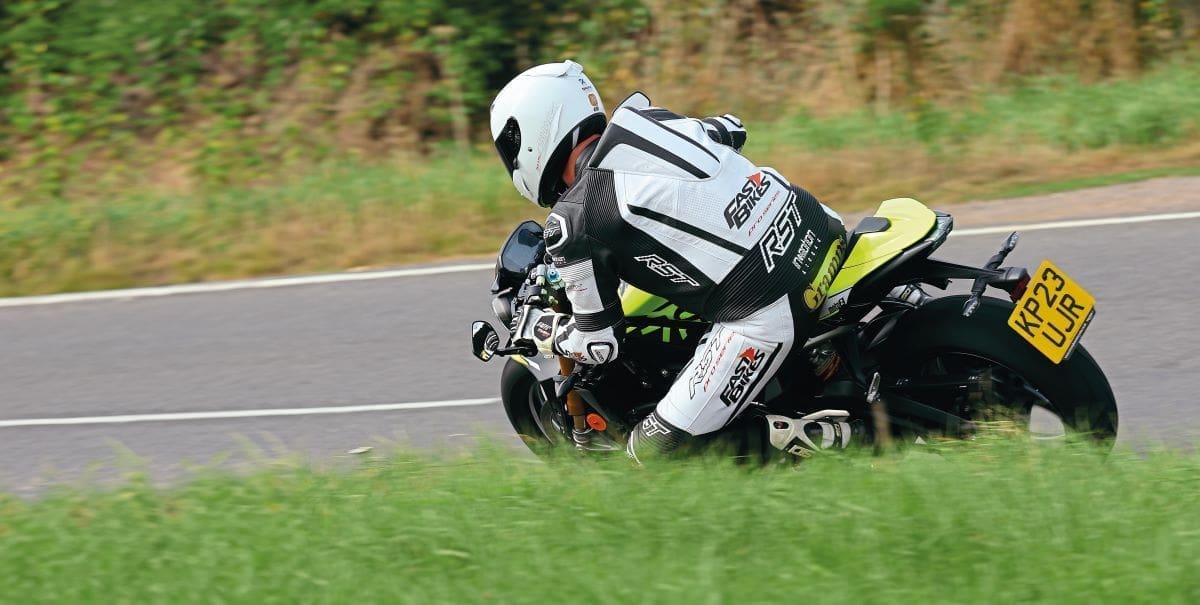
Is the Moto2 the answer to the gap left in the market by the demise of the Supersport sector? Apart from the fact you can’t actually buy one, and its price tag is £3000 more than the incoming ZX-6R from Kawasaki anyway, in the case of the Moto2, the answer is no. However, Triumph might just be onto something with the concept of a friendly-looking naked with the headbanging tendencies of a supersport bike.
It’s also worth noting that just because the Moto2 sits on top of the Street Triple range, it doesn’t necessarily make it the best Street Triple just because it has a higher spec. Crucially, it has completely different DNA underneath the familiar outline, and it rides so differently to the RS that it really isn’t comparable. It’s one of a kind.
Tech Data

Triumph Street Triple 765 Moto2
Engine
Type: 765cc, liquid-cooled, 3-cyl
Bore x stroke: 78mm x 53.4mm
Compression: 13.25:1
Fuelling: EFI
Claimed power: 128bhp @12,000rpm
Claimed torque: 80Nm @ 9500rpm
Electronics
Riding modes: Yes
Traction control: Yes
ABS: Yes
Quickshifter/autoblipper: Yes
Wheelie control: No
Launch control: No
Chassis
Frame: Aluminium bean twin spar
F ssuspension: 43mm Öhlins NIX upside down forks, fully adjustable
R suspension: Öhlins STX40, fully adjustable
Front brakes: Brembo Stylema radial monobloc, two-piston calipers
Rear brake: Brembo single-piston caliper, 220mm disc
Dimensions
Wheelbase: 1399mm
Seat height: 836mm
Wet weight: 188kg
Fuel capacity: 15 litres
INFO
Price: £13,795
From: triumphmotorcycles.co.uk


